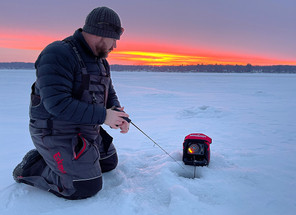Posted by Chris Larsen on 11th May 2021
Early Ice Perch Fishing
Early ice is one of the best times to chase perch. They’re usually staged up in shallow water flats and the thin ice tends to keep big crowds of hungry anglers at home. But shallow water and thin ice can spook fish. Being stealthy can be the difference between a perch dinner and an empty bucket. Like any other time of the year, finding perch is the first step in catching perch.
Perch are voracious feeders. One of the best aspects of perch fishing is they’re usually not too difficult to get them to bite once you find them. That appetite usually means if you can find their food, you can usually find the perch. Shallow flat areas with adjacent weeds are usually a great place to start. Not only are perch looking for food, they’re also looking for a place to hide from predators. These fish are looking for a meal and protection from being another fish’s meal.
Drilling a lot of holes is common advice when it comes to ice fishing. This advice is even more valid when it comes to fishing for perch. Drilling out a few dozen holes before wetting a line is a common procedure. An underwater camera is very helpful when it comes to finding the right spots. Weed edges, dips and humps in the lake floor, rock piles, and transitions from gravel to much bottom can be perch magnets.

Once you start fishing, move quickly. If you’re not marking fish or getting bites within a minute or two, it’s time to move to the next hole. If you start catching fish out of a particular hole, get your line back down as quickly as possible to get another fish. Tag teaming a hole with another angler is a great idea when the bite is hot. Schools of perch tend to move around and may only be under a particular hole for a minute or two. Tournament angler Al Escobedo says keeping the school interested is important. “If you have a school underneath you and your bait is gone for too long, they’re moving.” When the hole cools down, start moving to adjacent holes until you find the fish again.
Follow the fish and when you’re out of options, go back to hot holes. Those holes were good for a reason. Maybe there was a small dip or weed point that made that spot better than others in the area. I’ve often pulled several fish out of a hole before it cooled off and then returned an hour later to find another group of perch ready to eat under the same hole.
When it comes to bait and lures, just about anything goes for perch. Tournament angler Al Escobedo says perch aren’t picky. “They're not a finicky fish. You can use a large variety of baits and lures. Spoons and tungsten, anything you would use for walleyes or panfish work great. The big thing is always being ready and being quick. When I’m going fishing specifically for perch I usually have a couple of rods setup with different baits on them. I’ll have a spoon and then I’ll have a small tungsten.”
Want to learn more about early ice perch fishing? Press play on the player below to listen to Episode #95 of the Fish House Nation Podcast.

